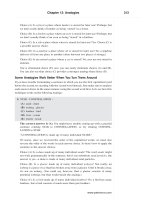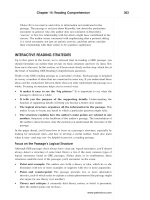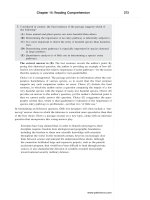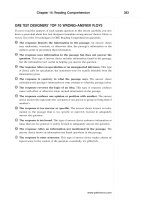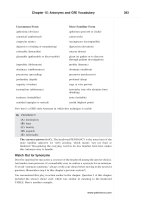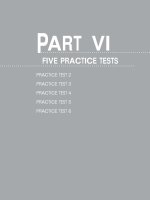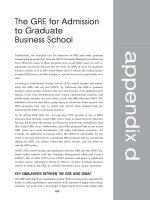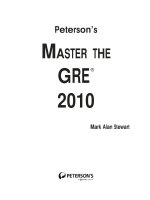Master the Gre 2010 - Part 39
Bạn đang xem bản rút gọn của tài liệu. Xem và tải ngay bản đầy đủ của tài liệu tại đây (49.5 KB, 10 trang )
Choice (E) is too narrow and refers to information not mentioned in the
passage. The passage is not just about Reynolds, but about the portraiture
encounter in general. Also, the author does not comment on Reynolds’s
“success” or how his relationship with his sitters might have contributed to his
success. The author seems concerned with emphasizing that a portrait sitting
is a social encounter, not just an artistic exercise, and that artists consider
their relationship with their sitters to be somehow significant.
INTERACTIVE READING STRATEGIES
Up to this point in the lesson, we’ve stressed that in reading a GRE passage, you
should formulate an outline that reveals its basic structure and how its ideas flow
from one to the next. In this section, we’ll focus more closely on this step, which lies at
the heart of handling GRE Reading Comprehension questions.
Think of any GRE reading passage as a structure of ideas. Each passage is designed
to convey a number of ideas that are connected in some way. If you understand these
ideas and the connections between them, then you truly understand the passage as a
whole. Focusing on structure helps you in several ways:
• It makes it easy to see the “big picture.” It is important to see what the
passage is about as a whole.
• It tells you the purpose of the supporting details. Understanding the
function of supporting details will help you become a better close reader.
• The logical structure organizes all the information in the passage. This
makes it easy to locate any detail to which a particular question might refer.
• The structure explains how the author’s main points are related to one
another. Structure is the backbone of the author’s passage. The interrelation of
the author’s ideas becomes clear the moment you understand the structure of the
passage.
In the pages ahead, you’ll learn how to focus on a passage’s structure, especially by
looking for structural clues, and how to develop a useful outline. You’ll also learn
when it may—and may not—be helpful to preview a reading passage.
Focus on the Passage’s Logical Structure
Although GRE passages don’t always have clear-cut, logical structures, you’ll almost
always detect a structure of some kind. Here’s a list of the most common types of
logical structures found in GRE passages. Either alone or in combination, these
structures underlie most of the passages you’ll encounter on the exam:
• Point and example: The author sets forth a theory or idea, which he or she
illustrates with two or more examples or supports with two or more arguments.
• Point and counterpoint: The passage presents two or more alternative
theories, each of which seeks to explain a certain phenomenon (the passage might
also argue for one theory over another).
• Theory and critique: A commonly held theory, notion, or belief is presented;
then the author points out its flaws.
Chapter 14: Reading Comprehension 363
.................................................................
..............................................................................................
www.petersons.com
• Pro vs. con: The passage presents arguments for both sides of a single issue or
presents the benefits and drawbacks of a certain policy or course of action.
• Compare and contrast: The passage points out similarities and differences
between two or more events, ideas, phenomena, or people.
• Historical cause and effect: The passage is a cause-and-effect sequence
showing how one event led to another (presented either in chronological order or
with later events described before earlier ones).
• Classification: The passage identifies and distinguishes between two or more
basic types, categories, or classes of a phenomenon, and then branches out to
subclasses. (This structure is most common in passages involving the natural
sciences.)
Now let’s look at some examples. First, here’s Passage 1 (about portraiture) again.
This time, key portions are underlined to help you see its structure. Notice how nicely
it fits into the compare-and-contrast structural pattern:
Renowned photographer Cartier-Bresson has expressed his passion for
portrait photography by characterizing it as “a duel without rules, a
delicate rape.” Such metaphors contrast sharply with Richard Avedon’s
conception of a sitting. While Cartier-Bresson reveals himself as an
interloper and opportunist, Avedon confesses, perhaps uncomfortably, to a
role as diagnostician and (by implication) psychic healer. Both
photographers, however, agree that the fundamental dynamic in this
process lies squarely in the hands of the artist.
A quite different paradigm has its roots not in confrontation or
consultation but in active collaboration between the artist and sitter. In
William Hazlitt’s essay entitled “On Sitting for One’s Picture” (1823),
Hazlitt described a “bond of connection” between painter and sitter that is
most like the relationship between two lovers. Hazlitt fleshes out his thesis
by recalling the career of Sir Joshua Reynolds. According to Hazlitt,
Reynolds’s sitters were meant to enjoy an atmosphere that was both
comfortable for them and conducive to the enterprise of the portrait
painter, who was simultaneously their host and their contractual employee.
Here’s a brief passage that combines the theory-and-critique and point-and-
counterpoint structures. Again, some key phrases are underlined to help reveal the
structure.
In the arts, we are tempted to think that true originality must surely
reside, so-called “new” ideas almost always embrace, apply, or synthesize
what came earlier. For example, most “modern” visual designs, forms, and
elements are based on certain well-established aesthetic ideals—such as
symmetry, balance, and harmony. Admittedly, modern art works often
eschew these principles in favor of true originality. Yet, the appeal of such
works lies primarily in their novelty and brashness. Once the ephemeral
novelty or shock dissipates, these works quickly lose their appeal because
they violate firmly established artistic ideals. Or consider rock-and-roll
music, which upon first listen might seem to bear no resemblance to
classical music traditions. In fact, both genres rely on the same 12-note
PART V: Verbal Reasoning364
.................................................................
..............................................................................................
TIP
Don’t expect paragraph
breaks to help you parse a
passage’s structure. A passage
with a complex structure might
contain only one paragraph.
Use paragraph breaks as
structural clues, but don’t rely
on them.
www.petersons.com
scale, the same notions of what harmonies are pleasing to the ear, the
same forms, the same rhythmic meters, and even many of the same
melodies.
Next, take a look at a brief passage that illustrates a pro-vs.-con structure. (Certain
key phrases are underlined to help reveal the structure.)
Twentieth-century technological innovation has enhanced the overall
standard of living and comfort level of developed nations. The advent of
steel production and assembly-line manufacturing created countless jobs,
stimulated economic growth, and supplied a plethora of innovative
conveniences. More recently, computers have helped free up our time by
performing repetitive tasks; have aided in the design of safer and more
attractive bridges, buildings, and vehicles; and have made possible
universal access to information. Of course, such progress has not come
without costs. One harmful byproduct of industrial progress is
environmental pollution, and its threat to public health. Another is the
alienation of assembly-line workers from their work. And, the Internet
breeds information overload and steals our time and attention away from
family, community, and coworkers.
Here’s a passage excerpt that incorporates the historical cause-and-effect structure
into a theory-and-critique structure. (The underlined phrases help show the
structure.)
History and art appreciation courses that study the Middle Ages tend to
focus on the artistic achievements of particular artists such as Fra
Angelico, a Benedictine monk of that period. However, Western civilization
owes its very existence not to a few famous painters but rather to a group
of Benedictine nuns of that period. Just prior to and during the decline of
the Roman Empire, many women fled to join Benedictine monasteries,
bringing with them substantial dowries which they used to acquire
artifacts, art works, and manuscripts. As a result, their monasteries
became centers for the preservation of Western culture and knowledge
which would otherwise have been lost forever with the fall of the Roman
Empire.
Finally, take a look at a brief classification passage, which incorporates a compare-
and-contrast structure. (Notice the four classes, having certain characteristics that
are compared and contrasted.)
The lava of quiet volcanoes is very liquid, and so it can escape through the
volcano’s crater and through cracks in its sides before too much pressure
builds up inside. In contrast, the lava of a Vulcanian volcano is extremely
viscous. Upon contact with the air, it immediately solidifies, forming a
crust on the crater’s surface. When enough pressure builds up beneath the
crust of a Vulcanian volcano, it cracks open and the volcano spews ash and
clouds of gas through the crack into the air above. Of the two other types
of volcanoes, Pelean and Strombolian, the Pelean is better known because
it is the most explosive type of volcano. In a Palean volcano, molten lava,
or magma, solidifies beneath the surface, forming a plug. Then, once
Chapter 14: Reading Comprehension 365
.................................................................
..............................................................................................
www.petersons.com
enough gas pressure builds up, the volcano bursts open, hurtling huge
chunks of solid magma, along with ash and gas, through the air.
Look for Structural Clues
Structural clues or “triggers” provide clues about the structure and organization of the
passage and the direction in which the discussion is flowing. The lists below contain
common trigger words and phrases. Watch for these words as you read the passage.
They’ll help you see the passage’s structure and follow the author’s train of thought.
These words precede an item in a list (e.g., examples, classes, reasons, or character-
istics):
first, second (etc.)
in addition, also, another
These words signal that the author is contrasting two phenomena:
alternatively, by contrast, however, on the other hand, rather than, while, yet
These words signal a logical conclusion based upon preceding material:
consequently, in conclusion, then, thus, therefore, as a result, accordingly
These words signal that the author is comparing (identifying similarities between)
two phenomena:
similarly, in the same way, analogous, parallel, likewise, just as, also, as
These words signal evidence (factual information) used to support the author’s
argument:
because, since, in light of
These words signal an example of a phenomenon:
for instance, e.g., such as,...isanillustration of
Make Brief Notes or an Outline
As you’re reading, take notes to summarize paragraphs or to indicate the flow of the
passage’s discussion. Notes can also help you locate details more quickly and recap
the passage more effectively. Keep your notes as brief as possible—two or three words
are enough in most cases to indicate a particular idea or component of the passage.
For complicated or dense passages, an outline is a good way to organize information
and to keep particular details straight in your mind. The following situations are ideal
for outlining:
• If the passage categorizes or classifies various things, use an outline to keep track
of which items belong in each category.
• If the passage mentions numerous individual names (of authors, artists, political
figures, etc.), use notes to link them according to influence, agreement or dis-
agreement, and so forth.
• If the passage describes a sequence of events, use a time line outline to keep track
of the major features of each event in the sequence.
PART V: Verbal Reasoning366
.................................................................
..............................................................................................
NOTE
It’s not possible to circle or
underline key words or to
otherwise annotate passages
on the GRE computer screen.
Also, to read even relatively
short passages, you’ll need to
scroll (using the mouse)—
which makes good note-
taking even more crucial.
www.petersons.com
• In chronological passages, mark historical benchmarks and divisions—centuries,
years, decades, or historical periods—that help to form the structure of the
author’s discussion.
Use arrows to physically connect words that signify ideas that connect together; for
example:
• to clarify cause and effect in the natural sciences or in the context of historical
events
• to indicate who was influenced by whom in literature, music, psychology, and
so on
• to connect names (philosophers, scientists, authors, and others) with dates;
events; other names, theories, or schools of thought; works; etc.
• to indicate the chronological order in which historical events occurred
When You Should Preview the Passage
Many GRE prep books recommend that you preview the passage by reading the first
(and perhaps last) sentence of each paragraph before reading it straight through from
beginning to end. This technique supposedly provides clues about the scope of the
passage, the author’s thesis or major conclusions, and the structure and flow of the
discussion. These techniques make sense in theory, but in practice they are rarely
helpful on the GRE. Here’s why:
• Once immersed in the passage itself, you’ll quickly forget most (if not all) of what
you learned from previewing.
• The technique calls for you to read the same material twice, which is hardly
efficient.
• Previewing takes time that you might not be able to afford under testing condi-
tions.
• Previewing involves rapid vertical scrolling, which adds to eyestrain.
• Although previewing may be helpful for some passages, for others this technique
is of little or no help—and there’s no way to know whether you’re wasting your
time until you’ve already wasted it.
The only time it makes sense to preview is when you’re running out of time. You can
answer some questions quickly, especially those that refer to highlighted portions of
the passage, by reading just that portion and maybe what immediately precedes and
follows it. And a quick scan of the first and last few sentences of the passage might
provide clues about the passage’s central idea or primary purpose, so you can at least
take educated guesses at some questions.
Chapter 14: Reading Comprehension 367
.................................................................
..............................................................................................
www.petersons.com
